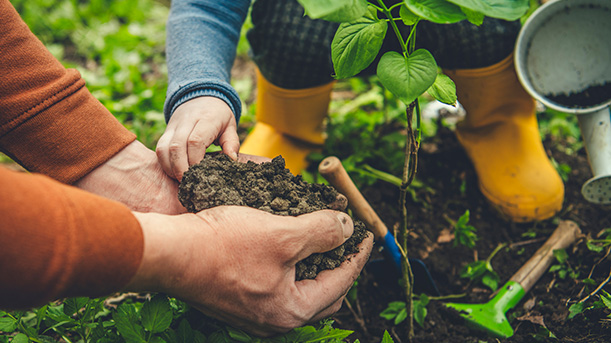BOOMbox at Home: Plants and Gardening
May 13, 2020

This week we’re exploring plants and gardening. Have you noticed how different types of flowers have started emerging from the ground as the weather has been warming up? Take a look at the trees and bushes outside--can you see little leaves opening up on the branches?
Here are three different activities you can try at home to learn about how plant size, shape, and variation, or what makes them different, help them grow.
Leaf Art
Following this leaf rubbing tutorial from First Palette, you can make beautiful art using leaves, white paper, and crayons or pencils.
On your next walk outside, pick a variety of leaves from the ground or trees. Whatever you find, be sure to just pick one, since that’s all you need for your print. You can also look inside your fridge to see what leaves you can find, like a spinach or rocket (arugula) leaf.
Once you have your leaf, place it on a table. Put a piece of paper on top, and rub the paper over the leaf lightly with a crayon or pencil. What happens? What shapes and textures do you see and feel?
Questions to ask:
- Why are some leaves darker in color and some leaves lighter?
- Why are some leaves very soft, and other leaves much hardier?
- What makes some leaves edible, and some leaves inedible?
- Why are some leaves much bigger than others?
Looking for more plant information? Here are two TED-Ed videos we recommend: one about the amazing ways plants defend themselves and another about the secret language of trees. We also recommend an article from New Scientist about why tropical plants have such large leaves.
Flower Pressing
As spring flowers bloom, you can use them to make flower pressings. FTD has a helpful tutorial on how to make flower pressings. For this activity, you’ll need an assortment of small flowers and parchment paper, plus a heavy book.
First, ask for permission to pick a flower from a garden, or find broken flowers on the ground. Next, sandwich the flowers between two pieces of parchment paper. You can organize the flowers however you'd like. Then place the parchment paper/flower sandwich inside a heavy book. In order to press your flowers effectively, you’ll have to wait for 2-3 weeks, so be sure to choose a book you’re not planning to read anytime soon.
After 2-3 weeks, your flowers will be fully pressed, and you can display your pressing in a window, on a table, or even use it as a bookmark. Some flowers retain their color when they dry out, and some flowers fade. What happened with your flowers? Why do some flowers fade and others don’t?
Plant Design Challenge
Tap into your creativity and design the weirdest, wildest, funkiest plant you can think of. Use any craft supplies on hand, like paper, markers, and scissors, and if you have things like cardboard, pipe cleaners, or even homemade clay, you can add those materials as well.
Not sure where to start? Here are some weird but real plants to investigate:
The Chicago Botanic Garden highlights some of the spooky plants you can find around the month of October.
Oxford University shares beautiful photographs and botanical drawings of weird plants. What’s your favorite? Our staff member Michelle says her favorite is the duck orchid, which you can only find in the eucalyptus woodlands of Australia, where she’s from.
You can also explore fictional plants in picture books that take you to magical lands. Use your library card to access electronic picture books from TumbleBooks if you need some fresh inspiration.
After you have designed your new plant, here are some questions to consider:
- What kind of environment would your plant live in?
- What does your plant need to survive?
- Can you use your plant for anything like food, medicine, or construction material?
- Does your plant have fruits or seeds?
- How does your plant prevent itself from being eaten by bugs and animals?
Scientist of the Week
Terese Adamiec is responsible for outdoor plant growth all year at the Chicago Botanic Garden. She also takes care of the plants that move indoors during the cold winter months. Terese has a bachelor of science in horticulture from the University of Illinois.
Share
We’d love to see the results of your experiments! Tag @skokielibrary when you share photos of what you’ve created on social media.
This week's post was written by Michelle.